I spent a week skiing in the beautiful Dolomites mountain region of the Italian alps. There’s not much to be said besides it is easily one of the most stunning regions for skiing you’ll ever come across in your life. I love skiing, but am not nearly as well traveled as I am for scuba diving. However, of the mountains I have been to, the Italian Alps are by far the most picturesque of them all. Until now, I’ve been to Whistler in Canada, Park City Utah, and numerous mountains in Colorado but the Dolomites are prettier than all of them.

The jagged peaks and vertical cliffs of the mountains here means they are not covered by snow and give off an incredibly dramatic view. The Dolomites is probably one of the largest mountain ranges for skiing. There are multiple mountain resorts within the area like Val Gardena, Alta Badia and its impossibly cute town of Corvara, Cortina D’Ampezzo, Kronplatz, Civetta, Arraba (and more) covering over 1,200km of ski trails. You only need one ticket (the Dolomiti superski) to visit them all. There are probably a hundred different little towns in the area that can be used as a home base with the bigger towns being closer to the lifts.
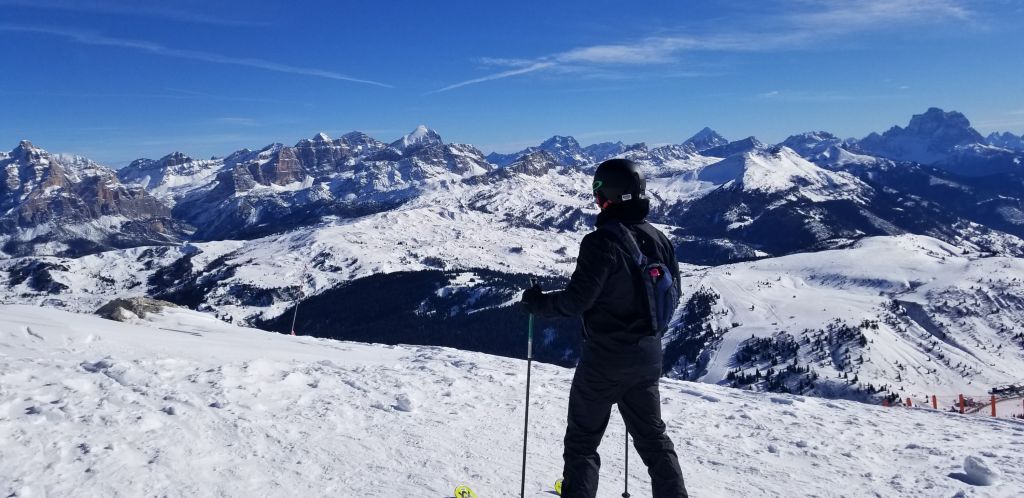
Getting to the Dolomites
Getting to the Dolomites is relatively easy by car from most surrounding European countries. The majority of skiers at the Dolomites make the trip by car from Italy, Germany, Austria, France, etc. We drove from Luxembourg and it was about 10 hours driving, hitting crazy traffic in the Austrian Alps.

By Air:
For those not within driving distance, there are many ways to get to the Dolomites mountain range. The closest airport to the mountains is Verona International Airport. From this airport, there are multiple buses that will take you to the towns surrounding the mountains.
Venice Airport is the closest major international hub to the region. From Venice, there are an array of options to get to the Dolomites but they will all take at least 3 hours. Renting a car will be the fastest of course. If you do not want to rent a car, the best option is to take a bus from the airport. Shuttles from the airport will run to numerous towns in and around Venice. Alternatively, you can take a train to Bolzano, and then another bus transfer to the town of your choice.
For people flying within Europe, Innsbruck Airport in Austria is one of the closest airports to the Dolomites. You can then rent a car and drive the 1.5-2hrs to the Dolomites, or take one of numerous buses to the town where your hotel is located.
Rent a car or not?
This question really depends on where you’re staying. If your hotel is nearby to a shuttle bus that will take you to the lifts (and most hotels do), this reduces the need to have a car. If you want to explore another town at night, then a car could be nice as taxis are quite pricey here. I think if you stayed in one of the more happening towns, and had shuttle bus access to the lifts, a car is unnecessary.
Best time to ski in the Dolomites
Skiing in the Dolomites and the Alps in general is a shorter ski season than that of North America. The season typically opens in December and ends in early March.
In December, the snow levels are likely quite low and most of the Dolomites ski range will be covered with man made snow. Much of the lower runs will probably be closed down in favor of places like the Marmolada glacier. This isn’t a bad thing necessarily because they have one of the most advanced snow making processes in the world. You won’t however see the mountains surrounding you covered in white which is special in my opinion.
From mid January to the end of February is the “peak” season for skiing. During this time, there is typically much more natural snow (as well as man made snow) which really brings to life the Dolomites winter. Accommodations during this period are the most expensive as all the Europeans come during these months. Ski season in general is 2-3x more expensive than in the summer seasons since it is so short.
With that said, everything is variable. You can have huge dumps of snow in December and warm 10 degree days in February. You just can’t predict it.
I’ve visited the Dolomites twice in mid February. The first time was insane amounts of snow blanketing the whole mountain range while the second time was less than average.
Price for skiing in the Dolomites
One of my favorite things about European skiing are the prices. Most of the skiing I’ve done in the past have been in the US where prices are astronomical. As of 2019, prices for Aspen is $180 USD per day! Lodging and food are also quite pricey so a ski trip ends up being a costly endeavor.
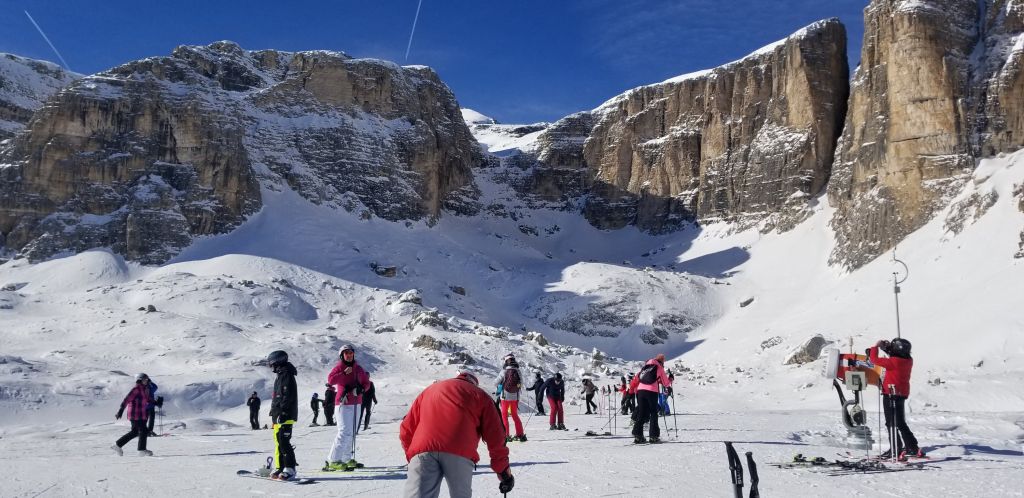
Enter Europe. Prices here are much more reasonable and you can expect to pay much less for just about everything. Along with Austria, Italy is one of the cheaper countries to ski in the Alps. Switzerland and France are considerably more expensive for lodging and food, but lift tickets are still quite reasonable.
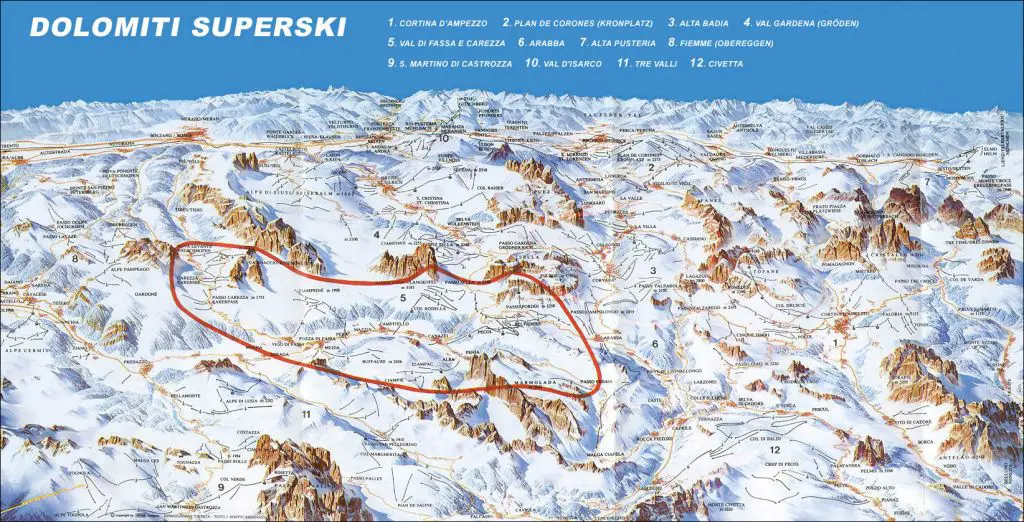
Lift tickets for the Dolomites
Lift tickets for the Dolomites are between €50 and €61 a day. The longer you ski, the cheaper prices you will pay. Some sample prices as of 2019/2020 are as follows:
| Consecutive days | Adults | Juniors 1 | Seniors 2 |
|---|---|---|---|
| 1 | € 61.00 | € 43.00 | € 55.00 |
| 2 | € 119.00 | € 83.00 | € 107.00 |
| 3 | € 173.00 | € 121.00 | € 155.00 |
| 4 | € 221.00 | € 155.00 | € 199.00 |
| 5 | € 265.00 | € 185.00 | € 238.00 |
| 6 | € 304.00 | € 213.00 | € 273.00 |
| 7 | € 322.00 | € 225.00 | € 290.00 |
| 8 | € 361.00 | € 252.00 | € 325.00 |
These prices will grant you access to the entire mountain range, which is an absolute massive area with hundreds of ski tracks. In addition, you can also buy tickets for certain parts of the mountains at a cheaper price. Val Gardena for example encompasses a large area to the northwest with more than enough tracks to keep you occupied for a day. A day pass is €56.
Expect prices to increase a few Euros a year after this table.
Rental Gear
There is an abundance of rental gear shops in the towns, and even nearby to the lifts. I went with Intersport which has multiple locations in the Dolomites. I rented the high performance skis, with boots, and helmet. Total cost is about €35/day for the entire set. Also, the longer you rent them for, the cheaper the prices are.
Sella Ronda Green Route
The Sella Ronda is a ski circuit around the Sella massif covering 4 Dolomite passes; Campolongo Pass, Pordoi Pass, Sella Pass and Gardena Pass and five villages; Arabba, Canazei, Selva Gardena, Corvara and Colfosco in Alta Badia. This is one of the most famous ski circuits in the world and the Dolomites claim to fame (outside of their incredible jagged peaks).
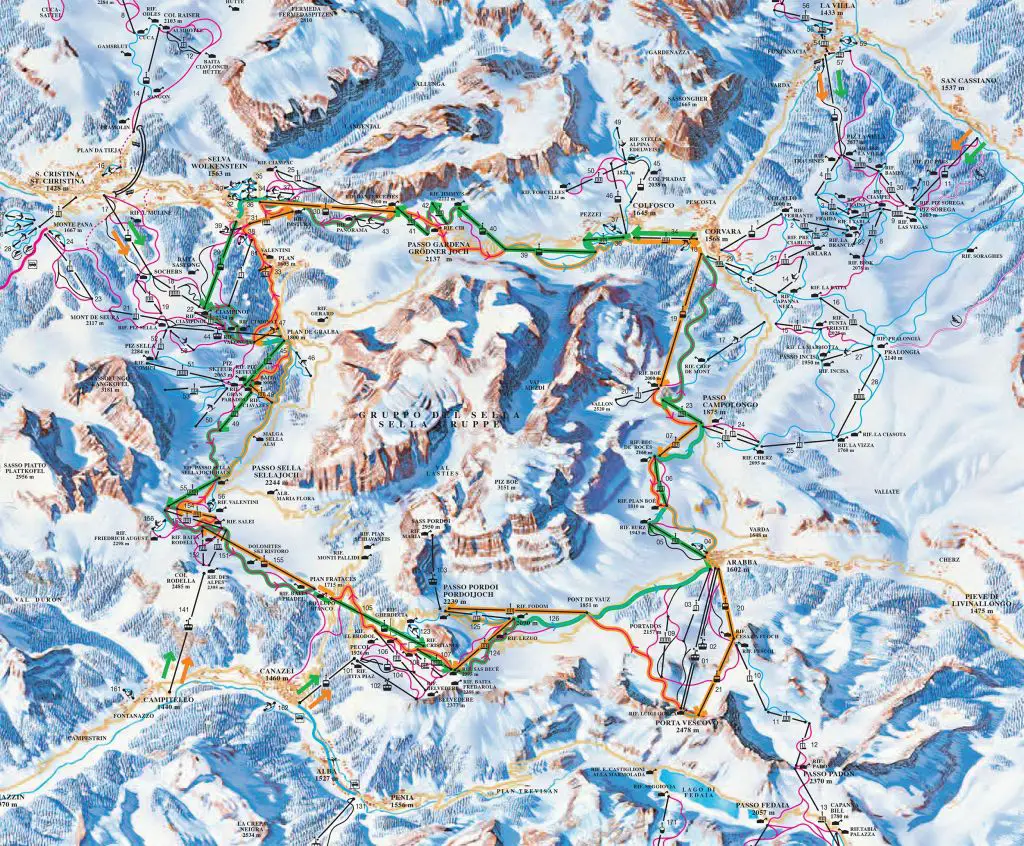
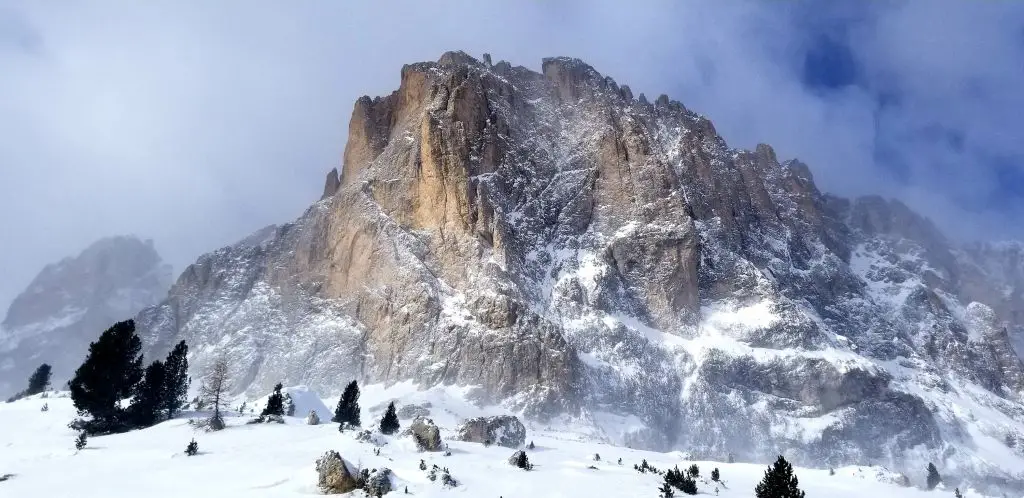

It has a length of 40 km of ski runs, of which you cover about 26 km skiing. The views of the mountains on the Sella Ronda are stunning, and in the clockwise direction you climb to the highest point at Porta Vescovo to an altitude of 2478 km, where you feel like you are near the sky.
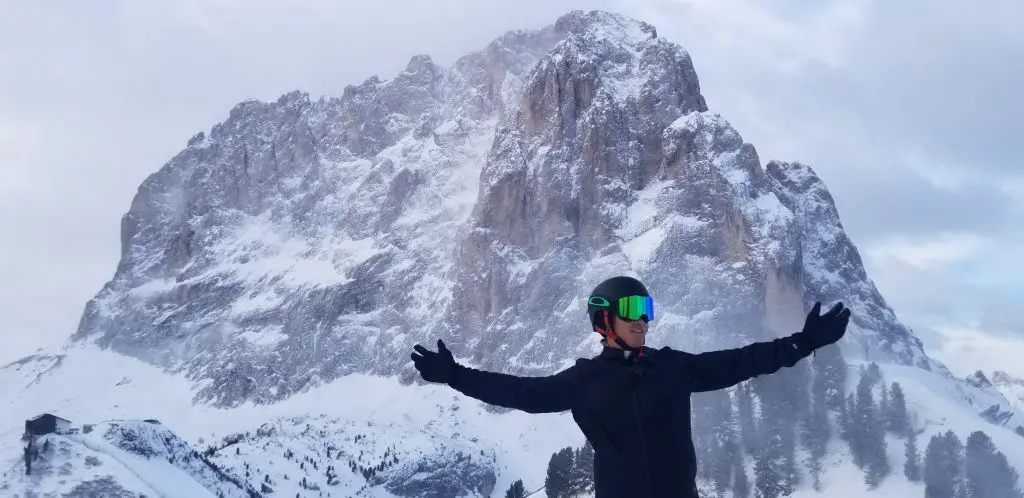
In general, I really enjoyed the green circuit. As we were staying in Santa Cristina, we took the Saslong lift to Selva Wolkenstein to start our circuit. Once you “get on” to the circuit, there are very clear signs indicating where to go throughout the circuit. All we had to do was just follow the green colored Sella Ronda signs to know that we were headed in the right direction.
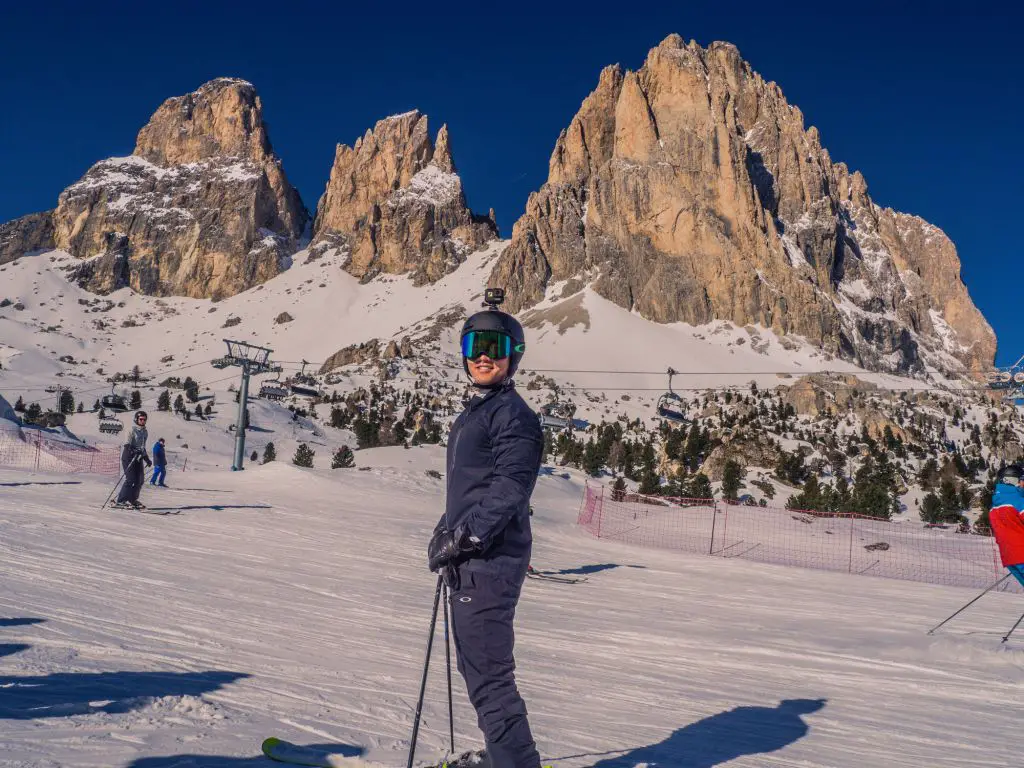
All in all, I found the skiing to be very enjoyable with a mix of reds and blues, and the possibility of doing blacks on some runs. We did the green route after a heavy day of snow so the powder was epic.
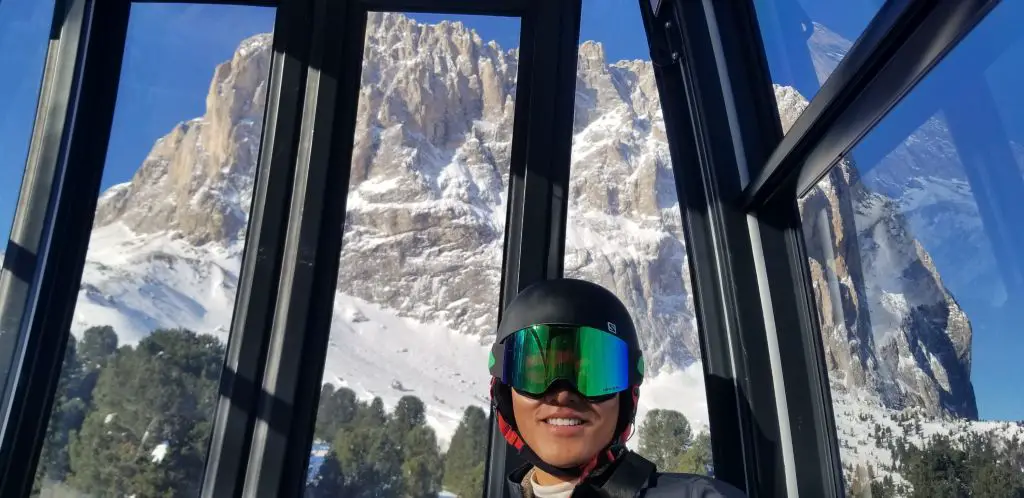
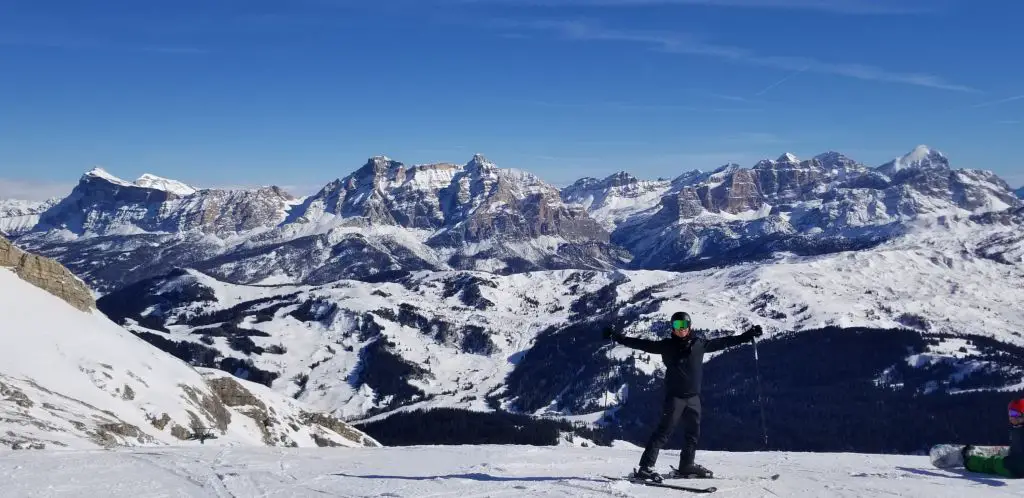
I can’t read Italian (not that you need to for this) so I have no memory of where I was and what I thought were amazing viewpoints. I was pretty speechless almost everywhere I went. The views of the mountain peaks are just absolutely insane. Even more insane that I was skiing alongside them.

The purpose of the Sella Ronda is not to just ski them as fast as possible (although this could be a fun challenge), but to really appreciate the landscape. Everywhere new we went, the mountains beckoned to be photographed. We took loads of pictures, along with all the other skiers who were equally as impressed. There are also plenty of restaurants where you can park the skis and enjoy the views over an aperol spritz.

How long to complete the Sella Ronda?
They recommend that you start no later than 10am to complete the circuit. I would definitely agree with this if it is your first time. We started the circuit around 9am (got onto the Green circuit). We were two skiers, and 1 snowboarder. We took numerous photo stops, a leisurely hour lunch, we completed the green circuit around 3pm. 5-6 hours is the average time I’ve read for completing the circuit and is about how long it took us. I think if you are a fast skier, packed your lunch, and were quick with photo stops, you could do it in 4 hours.
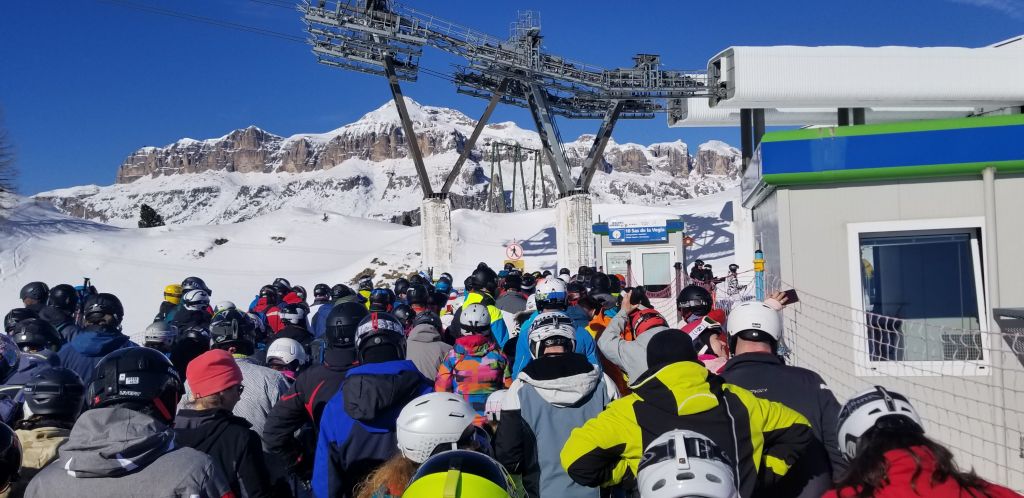
Sella Ronda Orange Route
The Sella Ronda Orange Route follows the same general path of the Green circuit but in the clockwise direction (Green is counterclockwise). The views are generally quite similar as you pass through the same areas in the Green route. However, the Orange circuit takes you to higher peaks with some incredible views.
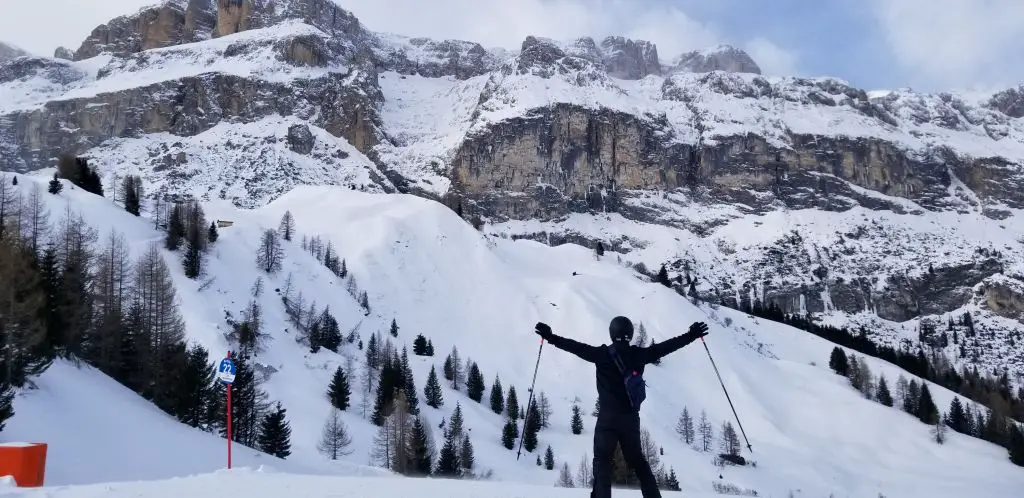
Visiting Sass Pordoi
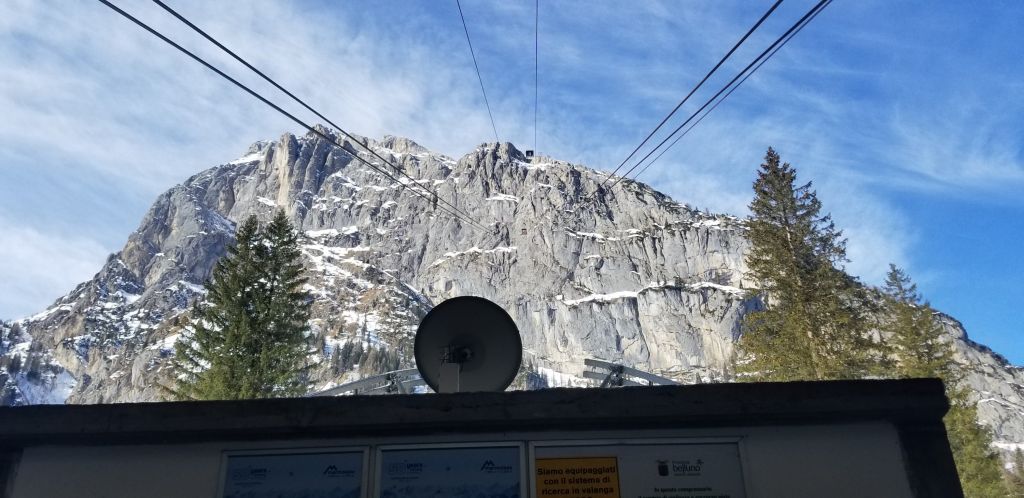
I think the main highlight of the Orange circuit for us was being able to visit Sass Pordoi. This was a slight detour off the Sella Ronda circuit but well worth it. From Arabba, we walked to the funicular that takes you up to the Sass Pordoi peak. At 3,200m high, it is one of the highest peaks of the Dolomites. The views are absolutely spectacular as you can see all the other mountains from the top.

You can also bring your skis onto the funicular and do backcountry skiing down the mountain. They had big signs saying that there are no official slopes here and anything you do is at your own risk. We didn’t end up chancing it, but regretted it after seeing how epic the skiing would have been from the top. There is also a restaurant here with spectacular views.
Sella Ronda Orange or Green Route?
So you’ve decided the Sella Ronda is a must do. The most pressing question follows: Orange circuit or Green circuit? This is the eternal question. Both circuits follow the same general direction, one is clockwise and the other is counter-clockwise. They overlap in some areas and then branch off to different ski lifts and viewpoints.

Most people choose to do at least one of these circuits in order to see all the highlights of the Dolomites. But is one better or more advisable than the other?

Being the crazy skiers that we are, we elected to do both circuits. We were hell bent on doing the orange circuit but kept getting lost and actually ended up on the green circuit on the same day, eventually completing that by the end of the day. We did the Orange circuit two days later (you’ll definitely need a rest day for this).
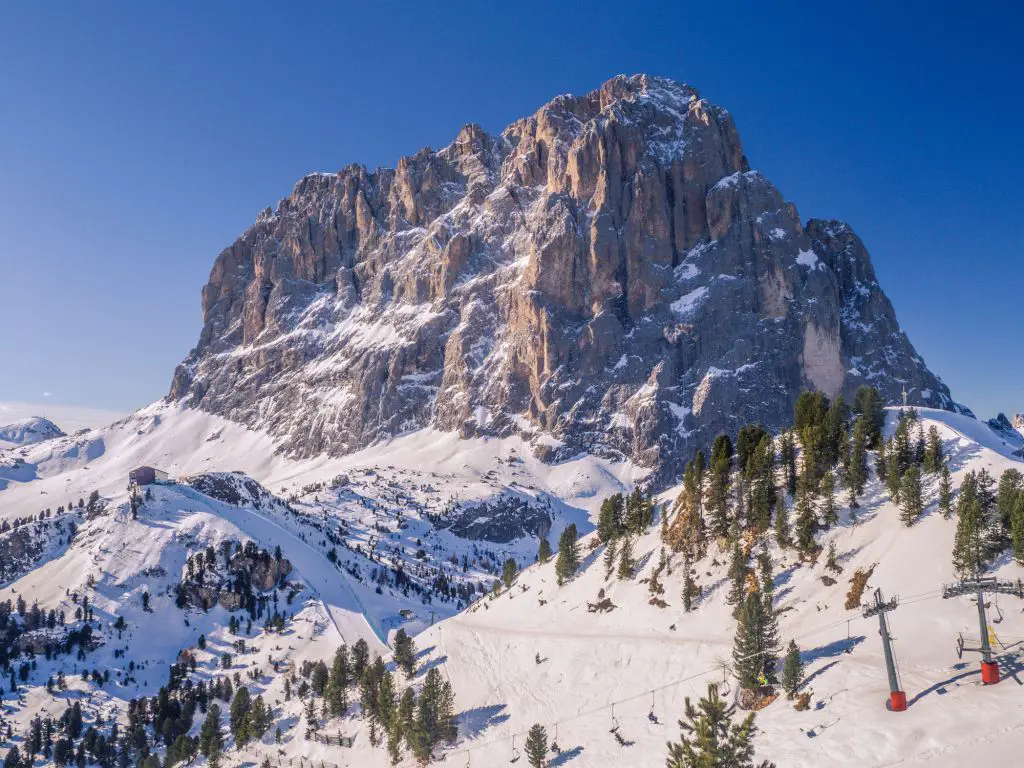
Ease of completion
After doing both circuits, I can safely say the Green circuit is the easier circuit. It is a shorter circuit (24km vs Orange which is 27km) for starters and the slopes are less steep than the Orange circuit. The orange circuit also has considerably more reds and blacks to ski down. These slopes will feel the effects of warm weather with icy and bumpy conditions inevitable by the afternoon. I’m not a fantastic skier and struggled getting down the moguls by the end of my orange ski day.

Views of the Dolomites
As far as breath-taking views go, the purpose of both circuits is to highlight how beautiful the Dolomites are. You will see absolutely mind-boggling views of the mountain range on both circuits. However, if I had to pick one, the Orange circuit has slightly better views as you get to higher peaks.

Also, it is only possible to visit Sasse Pordoi on the Orange Route. At 3200m, it is one of the highest peaks in the region and offers back-country skiing for those that are brave enough.
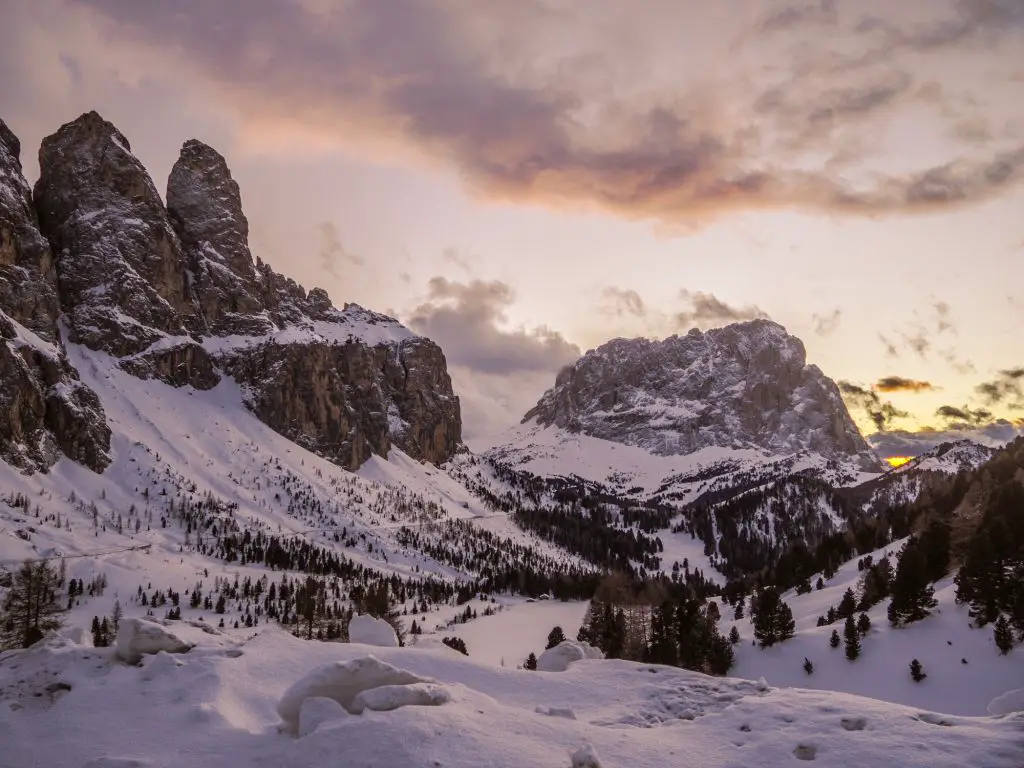
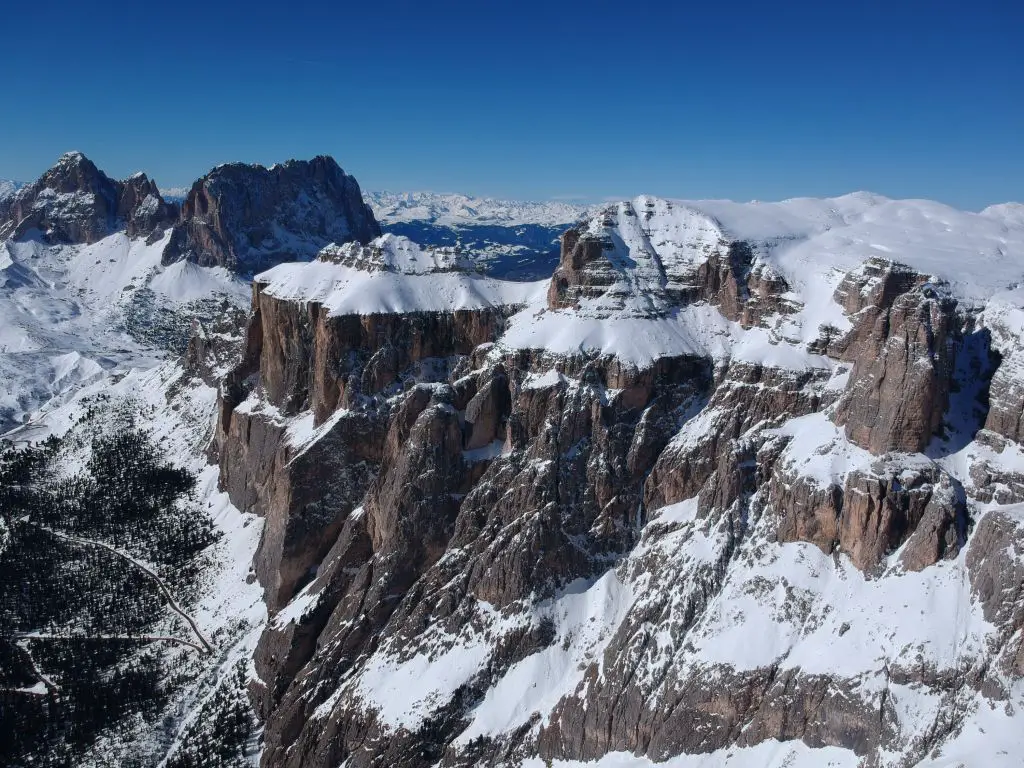
Marmolada
The Marmolada, also called “Queen of the Dolomites” is one of the most famous runs in the entire Dolomites area. It is the highest mountain in the Dolomites bordering Trentinto and Veneto. At 3,300m high, you can always count on good snow conditions here. The ski trail here goes all the way down to 1,400m with 12km of solid blacks and red trails.
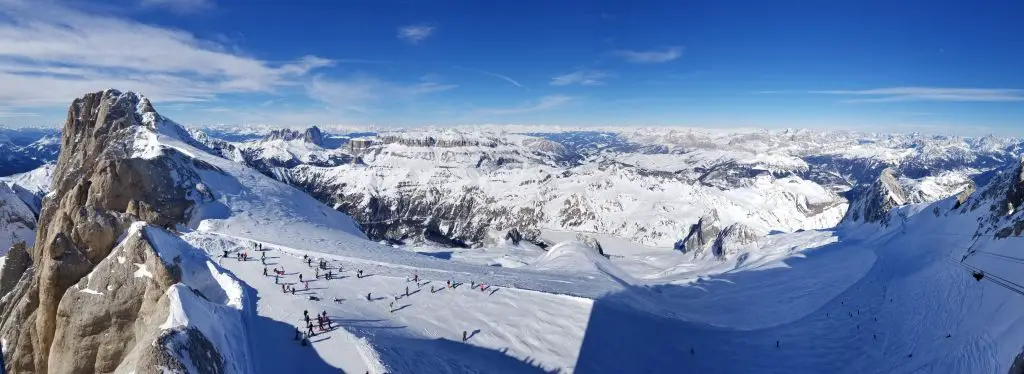
Located near Arraba, this run was located at the complete opposite end of the Sella Ronda circuit from Val Gardena. As we were here to ski, there is no better way to get to the Marmolada except skiing as driving would be almost 2 hours from Val Gardena to the Marmolada.

We started from our local Saslong lift, and skied along the Green Sella Ronda Route to Arraba. As we had already done this circuit, this part was relatively quick. From Arraba, it is another hour of skiing at least with multiple lifts to get to the base of the Marmolada! We arrived at the Marmolada around 11am but the lines for the lifts were hectic. We waited almost an hour before finally getting onto the gondola. The gondola stops half way where there is a restaurant (food looked mediocre though) with amazing views, before going all the way. All in all, it took us more than 3 hours to get here from Val Gardena.
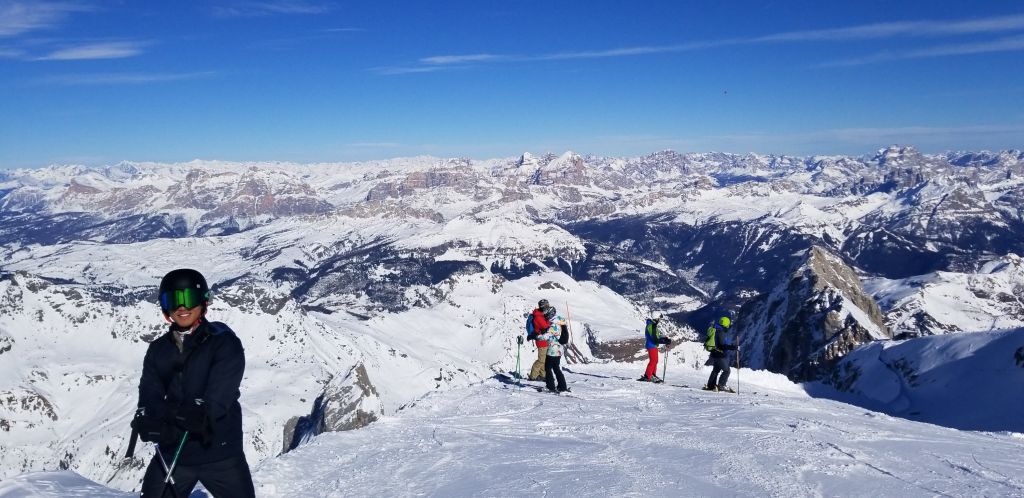
The views however, were totally worth it. You can see the entire mountain range from here and you are even higher than Sasse Pordoi. There is a viewing deck at the top here where you can snap some pics like we did. We finally started skiing at 1pm. The weather had been warm and there hadn’t been much new snow when we were here. By this time of day, the track was already worn and moguls galore were forming. If you’re not that good at skiing like myself, you may struggle to get down these steep black runs with moguls. Nevertheless, I took it slow and eventually made it down.
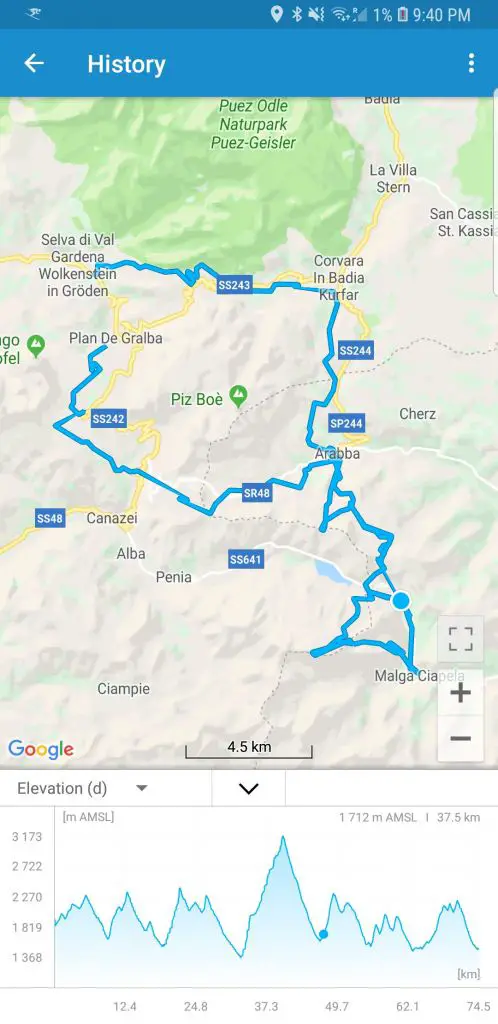
It took us awhile to finish the whole run at which point we had to worry about getting back to Val Gardena! We quickly got back to Arraba, and actually finished the rest of the Sella Ronda green circuit ending the day at 5pm. All in all, this was our most hectic (and glorious) day of skiing with over 50km of skiing done!
We had many Aperol Spritz following this to celebrate accordingly.
Sunny side of Val Gardena
The sunny side of Val Gardena is exactly what it sounds like. The sun shines down on this side for the entire day affording you amazing views and light. To get here, there is actually an underground train that connects from Saslong to the sunny side. From here, you can take a gondola to the top of Col Raiser where you can see the amazing peaks of Sasse Rigas and Furchetta.
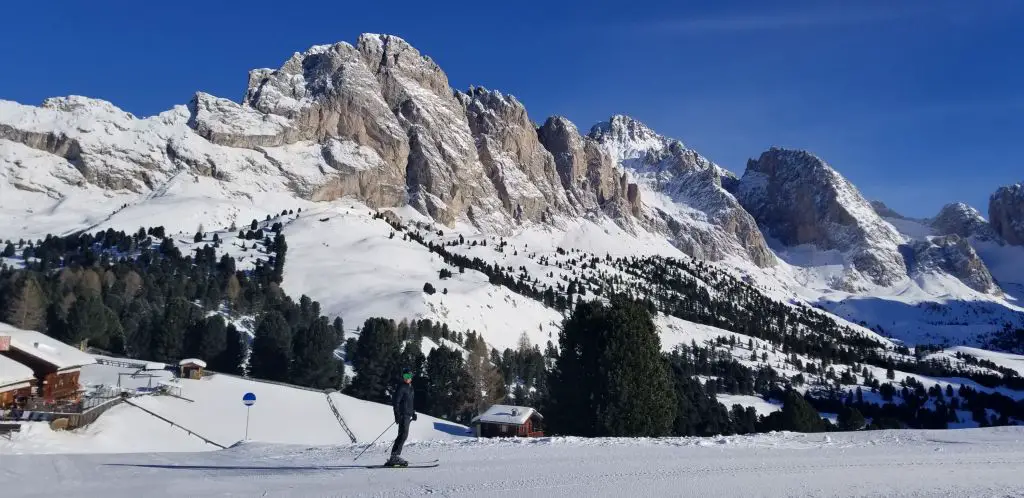

From here, it’s a short ski down to another lift that goes to the very top of Seceda where you can see everything around you. The run here was one of my favorites. It was steep, but very wide and flat which made it a real joy to ski down with some speed.

There’s also fantastic restaurants here including Baita Troier, Baita Sofie, and Baita Daniel. The views from any of these restaurants is absolutely insane. You can’t go wrong with any of them although I did prefer Baita Troier as it is more isolated from the main part of the slope.

10km ski run down to the town of Ortisei
The sunny side is also famous for the 10km run down to the town of Ortisei. This is a very scenic run with plenty of views and turns all along the way. It is relatively easy to complete as the distance means there is a plenty of wrapping around the mountain. From here, you can either call it a day and check out the town of Ortisei with its abundance of fancy restaurants, or go back to the top of Seceda and keep skiing the sunny side!
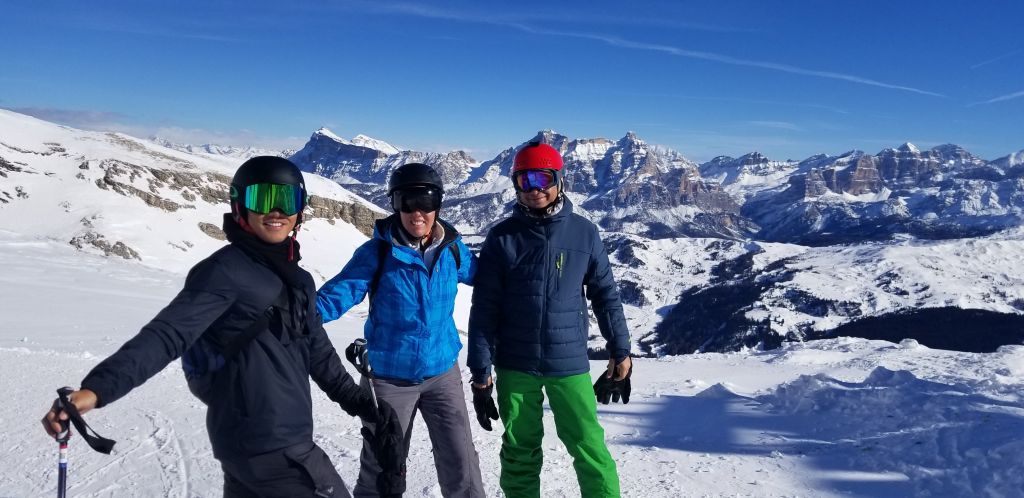
Where to eat and Apres Ski?
As you can imagine, there are hundreds of restaurants and apres ski bars to be had in the Dolomites region. The Apres ski game is strong here, and you can expect to see bars fill up starting around 4pm, and going until the late hours.
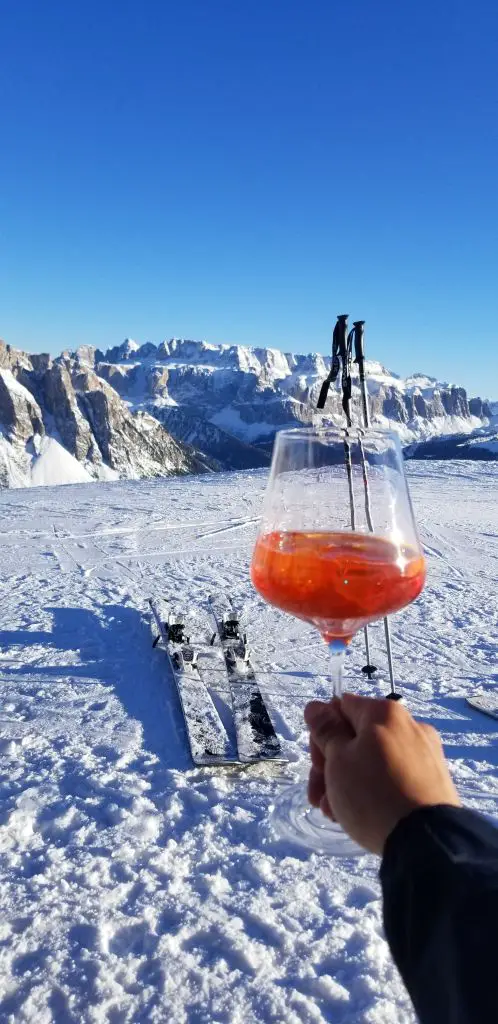
One of the unique things about skiing here and in Austria is the apres ski on the slopes itself. There are so many quaint restaurants all around the slopes with stunning views that also turn into apres ski destinations. There’s nothing like stopping for a quick aperol spritz while enjoying the insane views of the region.

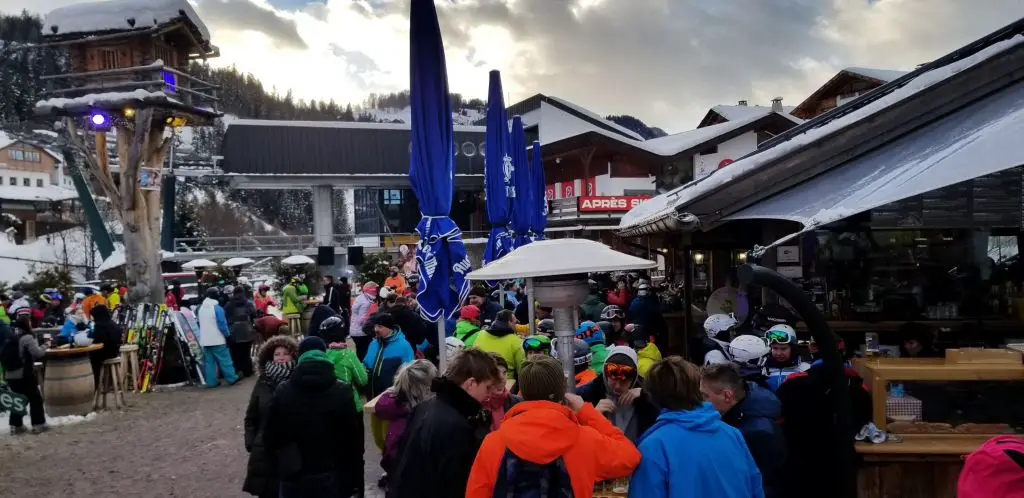
Restaurants in the area
As you’d expect, there are an incredible collection of fantastic dining choices in the area. As it straddles the border with Austria, you can find typical Tyrolean dishes as well as your standard Bavarian style fare like schnitzels and bratwursts. We mostly stuck to a diet of pizza and pasta on the trip. We’d have a big bowl of pasta for lunch at one of the nice restaurants on the slopes, while eating a pizza for dinner. One day, I mixed it up with a schitzel. Not the healthiest of diets but when you’re in Italy, it’s hard to not eat and enjoy their food.

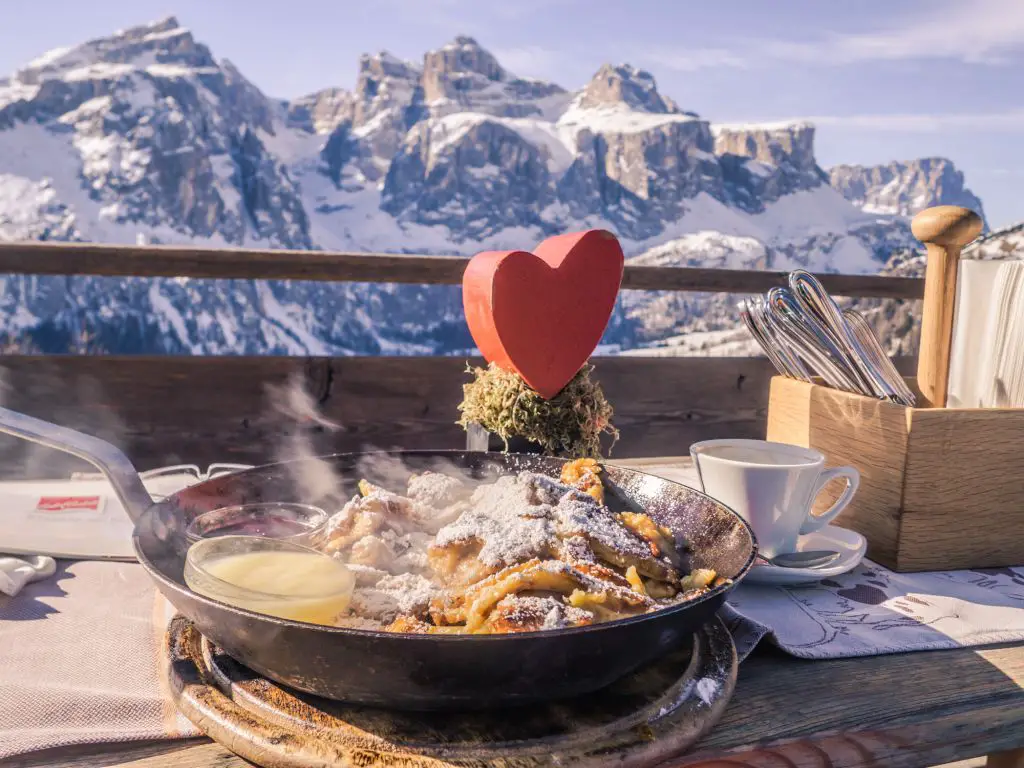
For dinner, we stuck to our area and found some delicious restaurants:
- L Medel
- L Fudle
- L Ciamin
- Pizzeria Sun Valley
- La Bula
Staying in Val Gardena
There are probably a hundred little towns to stay in and around the Dolomiti area. After extensive research, we settled on staying in the Val Gardena region (north west) in the town of Santa Cristina. Val Gardena is the largest ski resort in the Dolomites with 175km of slope length. It is easily connected to the other ski resorts by gondolas and is the perfect place to start your Sella Ronda Circuit.

We found a great apartment with views and ample space for six people. But honestly, there are hundreds if not thousands of places to stay in the region at all price points.
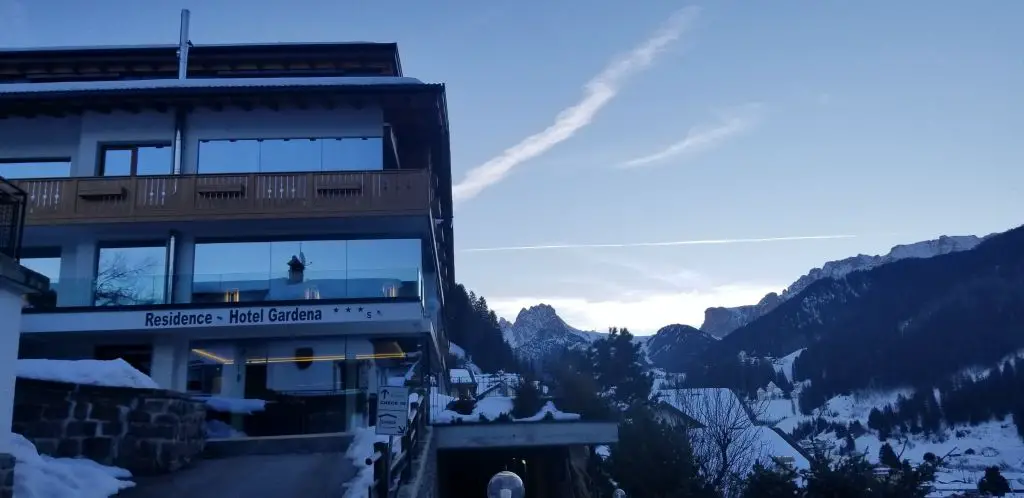
I think for first time visitors, staying near the Sella Ronda circuit (will get to this later) is great as it provides easy access to explore all the runs in the area.
The great thing about our hotel that the bus picked us up right outside the hotel. It took us to the Saslong ski stop which was a perfect starting point for the rest of the mountain.
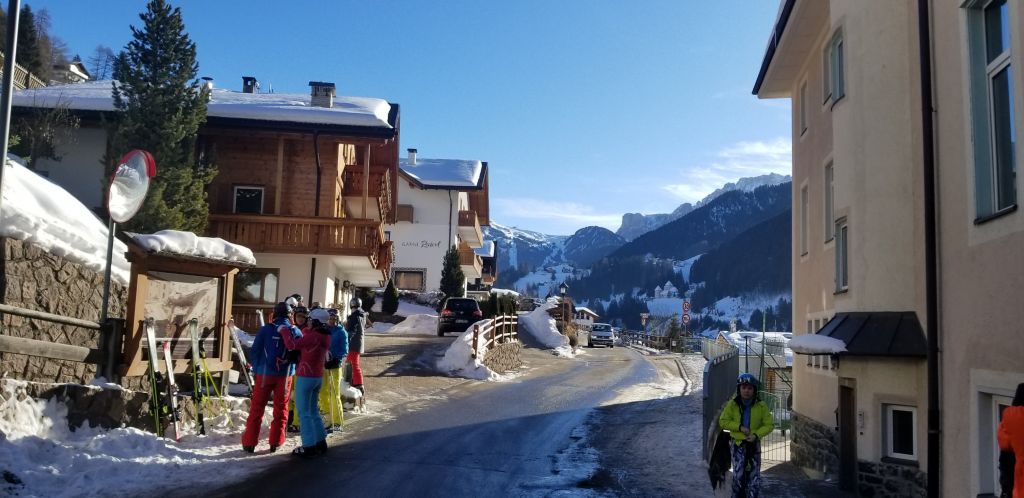
Staying in Corvara
In 2020, I came back to the Dolomites and stayed in the town of Corvara in Alta Badia as I thought it was the most picturesque place along the Sella Ronda. If you’re keen to stay in the cutest town along the Sella Ronda, look no further than Corvara!
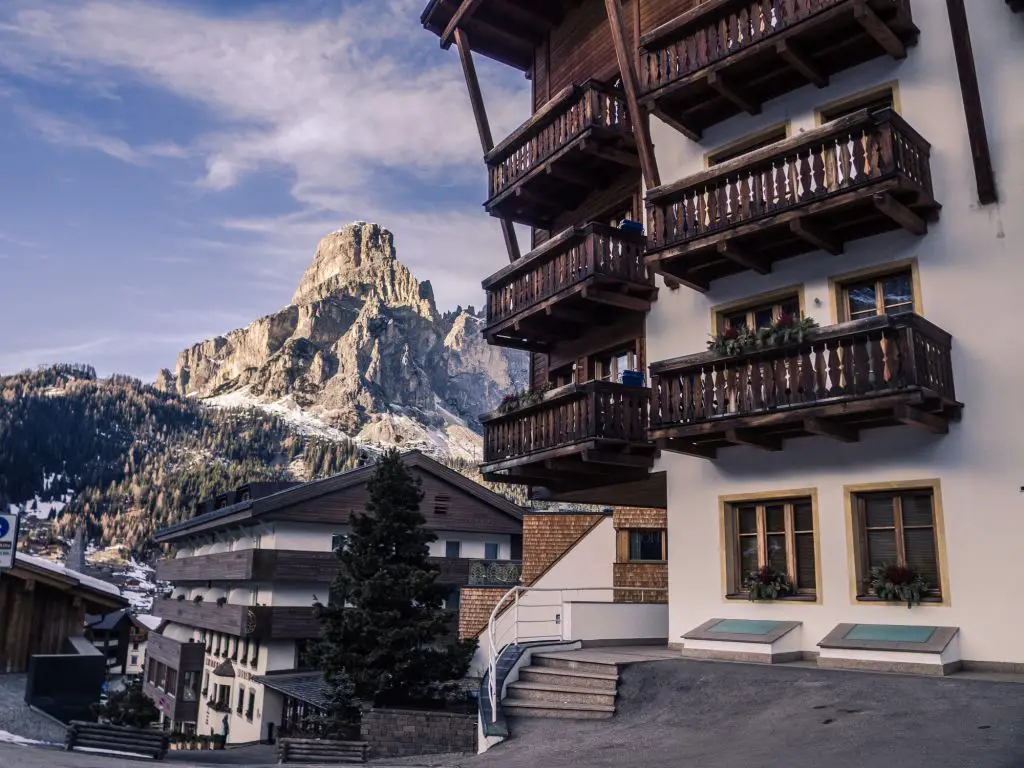
The other towns of the Dolomiti Region
The Dolomites is one of the biggest and certainly the biggest ski mountain range I’ve ever been to. There are over 500km of ski trails and more than 1400 square km of land. There is an insane amount of trails to discover.

Which town you stay in will dictate where you ski unless you are planning on driving in the morning. We stayed in Santa Cristina in the Val Gardena region of the mountains. We didn’t really explore any of the towns besides the ones nearby to Santa Cristina like Ortisei, Selva di Val Gardena, and Selva Wolkenstein. However, the beauty of the Sella Ronda circuit (more on that later), is it allows you to get a quick look at the neighboring towns. By neighboring, they’re really not that close but you can cover some serious distance by skiing and gondolas. Corvara on the eastern part of the circuit is almost a 1 hour drive from Santa Cristina.
This is not even remotely exploring the ski resorts that are not connected to the Sella Ronda like Cortina D’Ampezzo. There are numerous other mountains that you can reach by car but we had more than enough to explore while we were here.
Where to stay in the Dolomites?
There are probably a hundred little towns in and around the Dolomites region that have access to a ski lift of some sort. It’s impossible to say “this is the best town” to stay in with so many choices.
However, I think some towns are definitely more convenient than others as far as accessing as much of the mountain as possible.
If you have plans to the Sella Ronda circuit or plan to explore other parts of the mountains not nearby to your hotel, I would recommend staying in a town that is on or near the Sella Ronda Circuit. This includes towns in Val Gardena like Santa Cristina, Selva, Selva Wolkenstein, Corvara, Ortisei, Campitello Di Fassa, Arraba, Colfusco, Canazei, etc.
Again the collection of different ski resorts in the Dolomites is easily one of the biggest in the world so where you stay really dictates where you will hang out for the duration of your trip.
One week skiing itinerary for the Dolomites
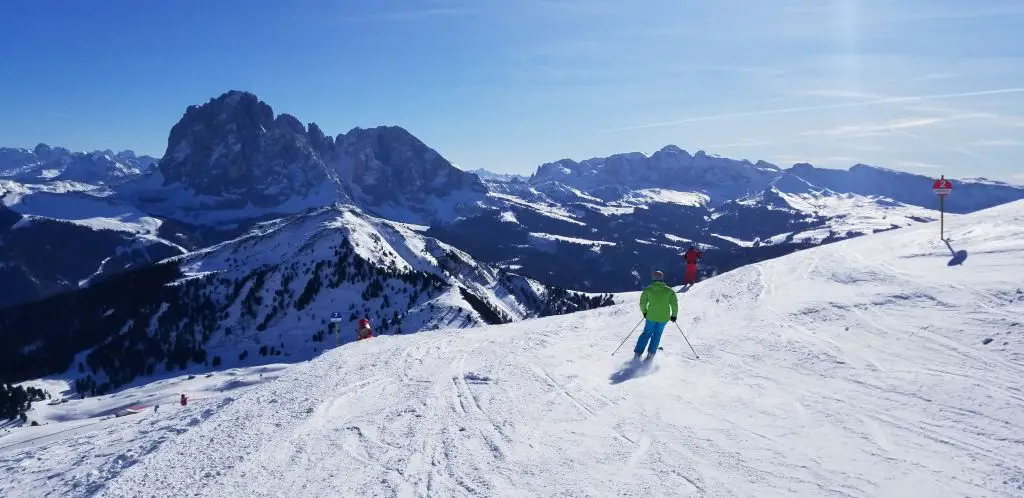
Most Europeans come here and ski for the week. The standard schedule is arriving on Saturday, skiing Sunday to Friday, and leaving the following Saturday. In fact, many of the hotels in the region only rent by the week during ski season, and the week always starts on Saturday. We did exactly this. Again, the Dolomites are absolutely enormous and there will be more than enough to keep you busy for a week. This is how we structured our ski adventure through the Dolomites:
Day 1:
Hit the slopes and get acclimated to the skiing. I hadn’t skied in a few years so I needed some warm up runs before tackling the rest of the mountain. We mostly stayed close going on the Selva Wolkenstein and Ciampioni lifts. In the afternoon, we felt adventurous and took a few lifts across to the town of Corvara in the Alta Badia region. We went down some runs here and really enjoyed it.

Day 2:
Sella Ronda Green circuit. This is the easier of the two circuits which was perfect after a mild first day. End with apres ski.
Day 3:
Sunny side of Val Gardena. This is a beautiful area nearby to our hotel. The skiing here is more enjoyable with lots of wide lanes and well groomed slopes. There is also the famous 10km run from the top to the town of Ortisei.
Day 4:
Orange Circuit. Day 3 was a mild day so Day 4, we hit it hard again to do the other circuit. We also took a 1 hour detour to visit Sasse Pordoi. I would recommend starting early for this day.
Day 5:
We went really aggressive and did the Marmolada glacier on this day. From Val Gardena, it is literally on the complete opposite side of the mountain range so it took us almost 2 hours just to get to the base of the Marmolada. We followed the green circuit which is the fastest way to get there. Even by car, it would have taken us over 1 hour to drive from Val Gardena to Arabba. After skiing down the Marmolada, we took the green circuit the rest of the way home. This was by far our craziest ski day. Not only did we complete the Green Circuit, but we also took a huge detour to do the Marmolada (which is itself challenging).
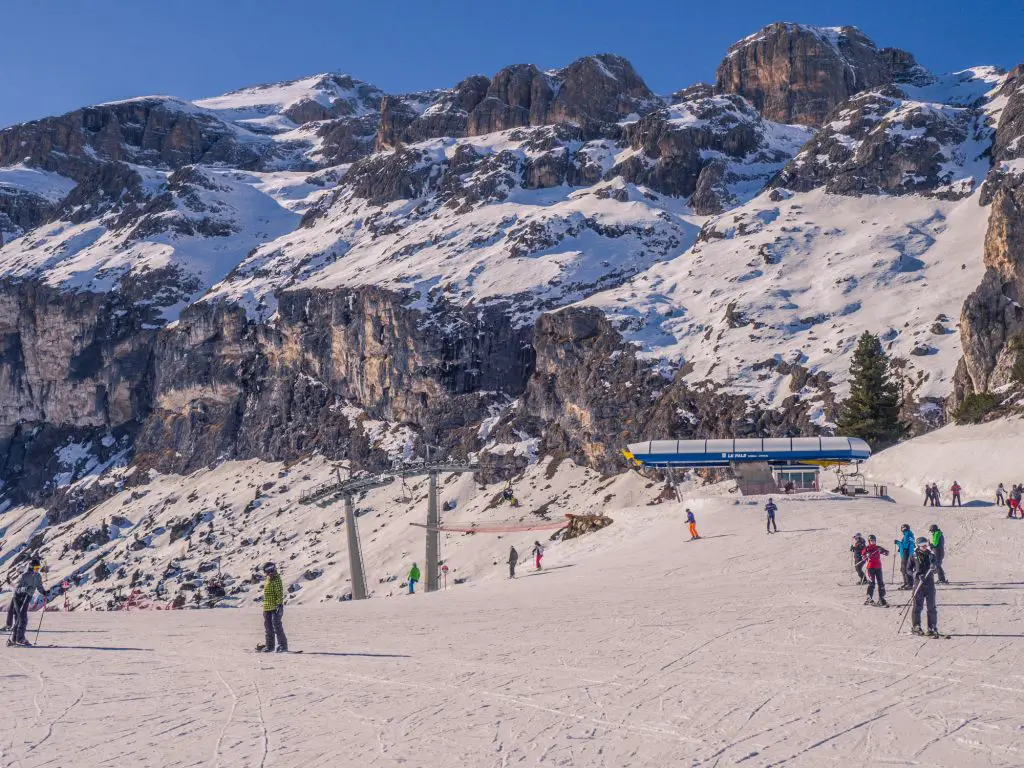
Day 6:
Last day skiing. We took it easy and went back to the Sunny side. The views here are just spectacular and we loved there restaurant options here. We skied the 10km run again, and did apres ski promptly at 3:30.




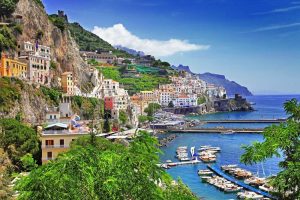
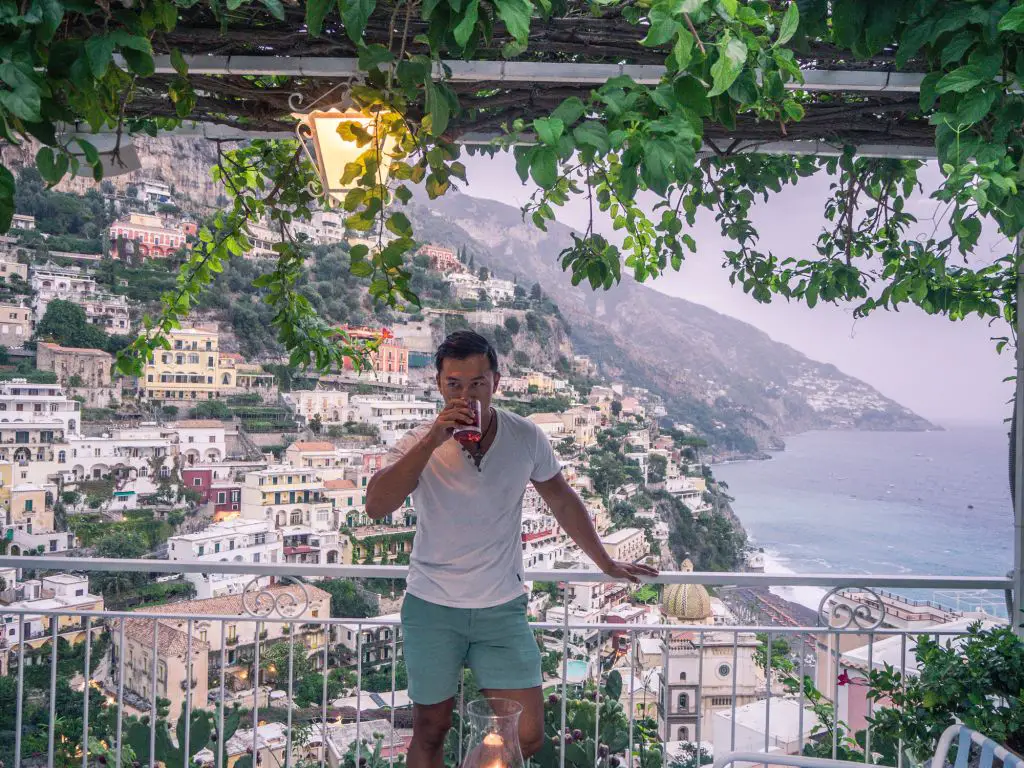
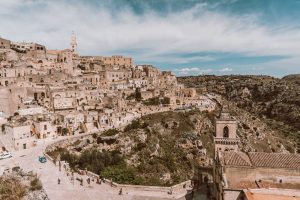
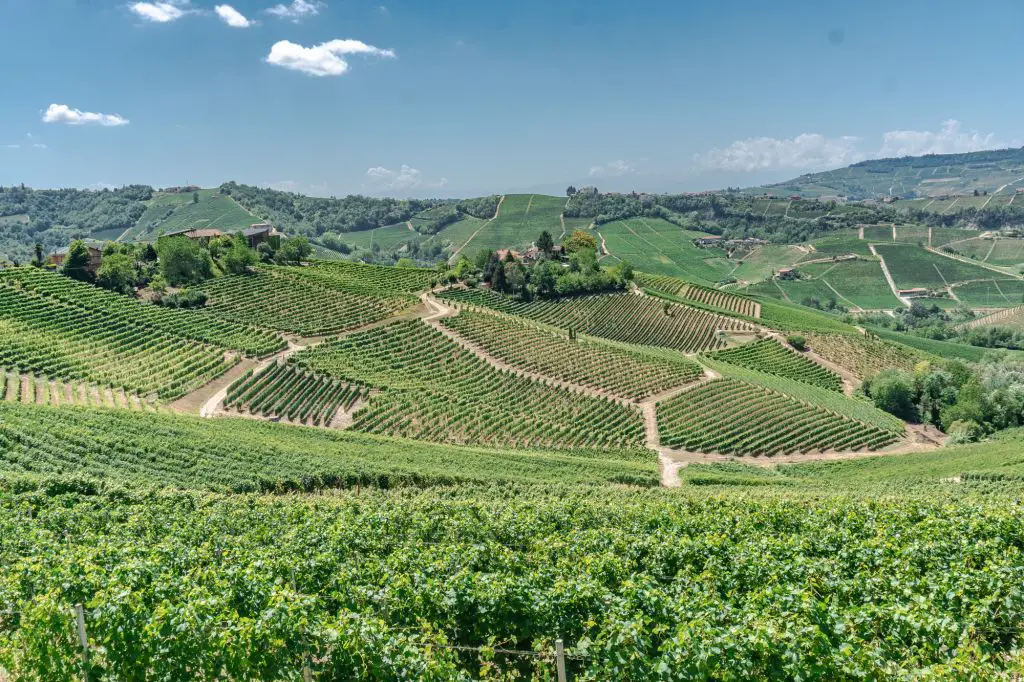


What an informative articleabout skiing in the Dolomites, one of my all times favourite ski region. The Sella Ronda is a total must and a highlight for every passionate skier. Thanks for the good read!
Thank you!
This post was so helpful for our recent January trip to the Dolomites.
Thank you greatly! From two Canadian snowboarders
Hey glad you liked it and hope you enjoyed the dolomites! Still my favorite mountains as a fellow Canadian that grew up skiing whistler